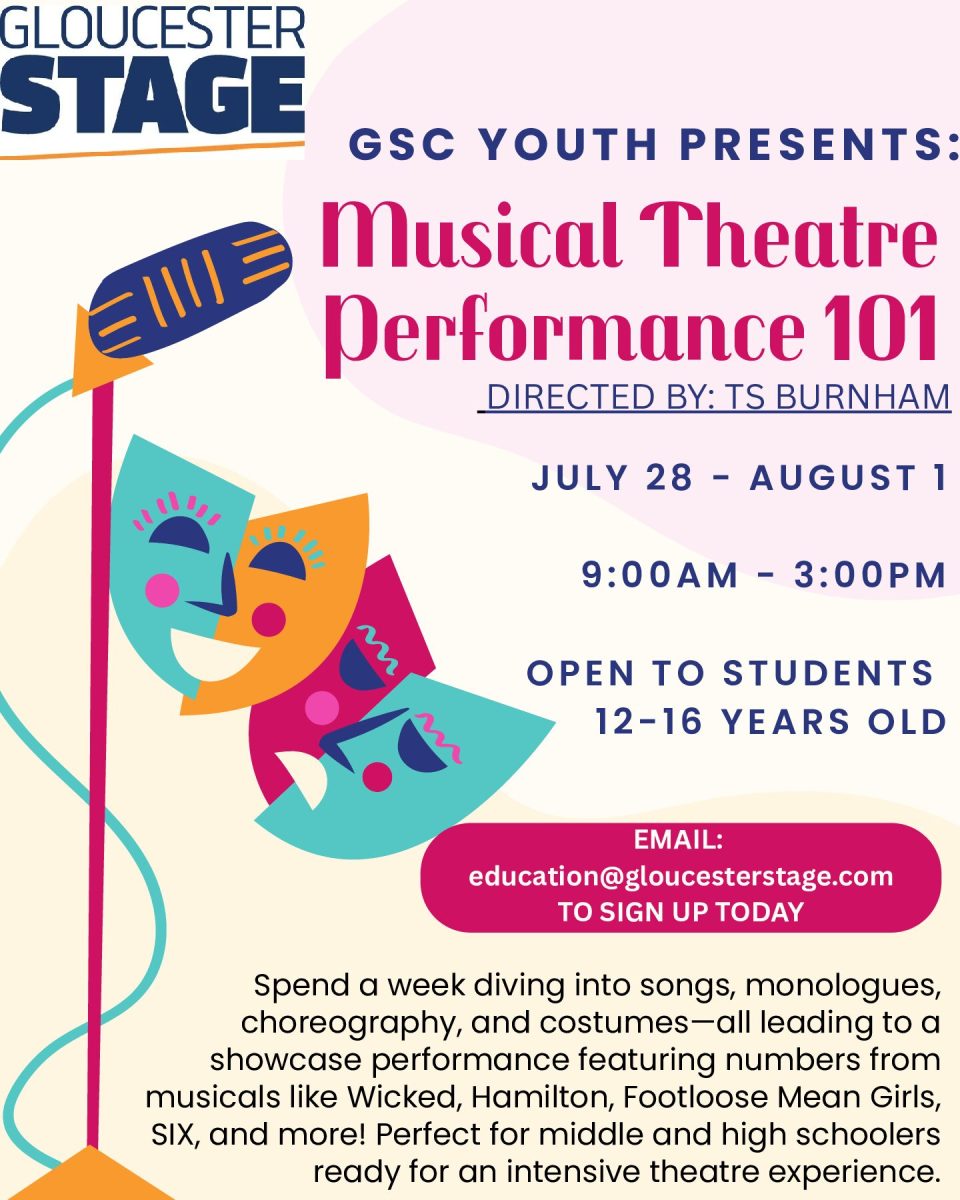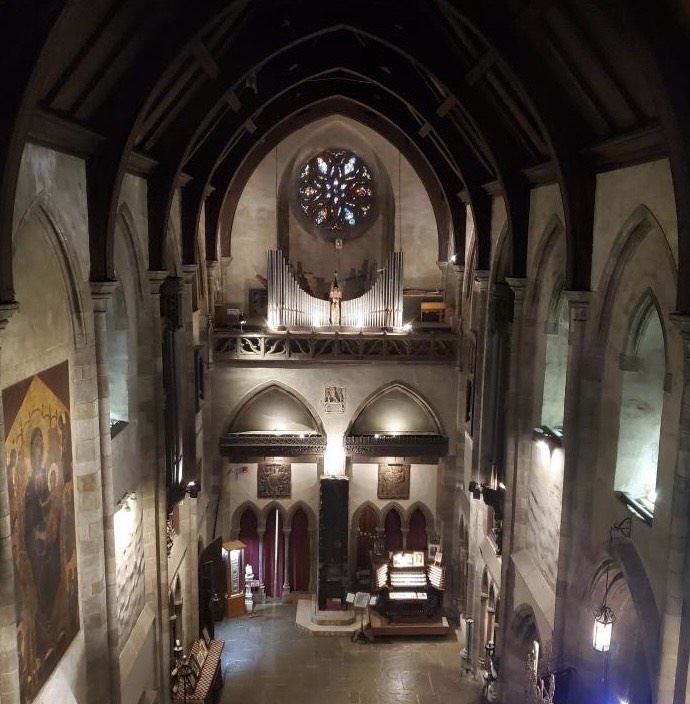Hammond Castle is worth caring about
Picture of the Hammond’s Castle interior
June 12, 2023
When wandering around Gloucester, there are many different places to visit, from beaches to restaurants to hiking trails. However, when driving through the backroads of Magnolia, you may see something that catches your eye: a giant, 16th century European castle. This castle on the New England shoreline was home to eccentric millionaire inventor John Hays Hammond Jr., his wife Irene, and his dozens of cats.
John Hays Hammond Jr. had the castle built for two reasons. One, as a “wedding gift” to his wife Irene, and two, to house his large collection of artifacts from eras spanning from the ancient times to the Renaissance. (The former reason was an excuse for the latter)
Hammond Castle Museum is a popular destination for not only Massachusetts natives, but people all over the United States. There are a plethora of reasons why people should visit this castle, from the architecture, to the story of Hammond, and even the rumors that surround the building itself.
After working there for 2 years, I can say that a majority of people asked me whether or not it was haunted after they finished their tours, with a burning passion in their eyes that said “please don’t say its not haunted because then I wasted 20 dollars touring a not-haunted castle,” to which I would respond with an unambiguous “maybe.”
However, this passion has birthed many rumors that would plague the visitors of Hammond Castle, and the employees alike.
The most popular rumor by far is that the castle is haunted. Exactly who haunts the castle varies depending on whom you ask. Some people think Hammond haunts it, and others think Irene does.
“In my experience in the years I worked at Hammond Castle Museum, many patrons would ask, “is it haunted?” …to which I would answer yes and no,” says Maureen Cleghorn, who worked at the castle as the gift shop manager for 2 years. “Not in the way they were expecting. However, there are definitely different energies throughout the building at different times that I myself have noticed.”
The interesting thing about the haunted rumor is that Hammond didn’t die in the castle, but in New York, so it seems impossible that he could possess the castle. Irene could be more likely, but unfortunately we don’t know the location of her death, so whether she died within the castle is a mystery.
Hammond or Irene might not be wandering the castle, but it could be something else entirely.
“If Hammond Castle Museum is haunted, it may be caused by the artifacts Hammond had sent over from Europe during the construction of the building,” said Cleghorn. “The many tombstones in the walls and ancient artifacts such as the child sarcophagus may very well have energy attached to them.”
One of the most ridiculous (and disturbing) rumors to circulate through visitors of Hammond Castle is that Irene was buried in the walls. Honestly, I have no clue where this originated. Irene passed away before Hammond and was buried on her family’s property. The public didn’t know where she was buried for a long time, and people still ask to this day where she is, so it’s possible that her being buried in the walls was made up to add to the mystery of her location.
Although all of the rumors surrounding Hammond Castle are false, the ghostly aspect is what keeps people interested.
One of the most popular attractions the castle has, is their nighttime spiritualism tours that begin in October, which details the spiritualist movement in the early 1900’s, something that Irene was heavily involved in.
Aside from the haunted aspect of the castle, many people who come through are very interested in the architecture and artifacts in the castle. According to the website, Hammond was described “as a man of the future, but who chose to live in the past,” and this is evident when admiring the structure of the castle.
From my time working at the castle, I can remember many moments trying to navigate winding staircases or squeeze through tiny doors that were made to mimic medieval European homes. Although frustrating at times, I never got tired of the atmosphere that the architecture created. It truly makes you feel like you time traveled back to Europe, minus the deadly plagues.
“His vision for the building was for it to be medieval in style–yet bridging several periods–so as to incorporate his expanding collection of stand-alone Classical antiquities through 16th century architectural elements,” states the Hammond Castle Museum website.
The architecture serves as a complement to Hammond’s large collection of artifacts, spanning centuries. It includes ancient tombstones, jewels, and an eerie skull which belonged to one of Christopher Columbus’s explorers. However, his grandest item has to be the gigantic pipe organ located in the Great Hall, built by a collection of world-famous pipe organ builders over 10 years, according to the website.
“Consisting of 8,400 pipes it was among the largest pipe organs in the world and incorporated many of the features of Hammond’s 19 patents for pipe organ technology,” according to the website. “The design of the wind boxes, as well as the placement and installation of the organ within the Great Hall were in keeping with Hammond’s style.”
In my opinion, one of the most interesting aspects of Hammond Castle Museum is the man who had the twisted idea of building a castle in New England in the first place, John Hays Hammond Jr.
Hammond was born in San Francisco in 1888, but moved as a young boy to the Transvaal in South Africa, where his father gained wealth because of his involvement in the mines in that country.
After moving back to the U.S., Hammond attended Yale University where he became interested in the new field of radio waves. After graduating in 1910, Hammond apprenticed at the U.S. Patent Office, and after that he started the Hammond Radio Research Laboratory in his parents estate in Gloucester, Massachusetts, which is a street away from the castle.
Over the course of his career, he was awarded over 400 patents. Many of these were in radio control, which would give him the title the “Father of Radio Control.” These inventions brought him wealth along with his inherited wealth from his father. The castle began construction in 1926, and was finished in 1929.
While Hammond’s early life is certainly interesting, his life while living at the castle is fascinating, and many visitors are entertained to learn more about his endeavors.
Hammond was a known prankster, and commonly played jokes on his guests that would stay in the castle. In one of the bedrooms, the Early American guest bedroom, the doors had the same pattern as the wall. At night when they were asleep, he would sneak in and shut the doors, so that when his guests woke up they would think they were magically sealed into the room overnight.
During parties, Hammond would jump into the pool in the Courtyard to his guests’ horror, who thought the pool was much deeper than it appeared due to the green dye clouding the water.
When living in the castle, Hammond owned dozens of cats, which he treated like his own children. Outside of the castle is the cat garden, which was connected to a window so his cats could go outside as they pleased. This is also where he is buried.
Its no doubt that Hammond Castle Museum is a sight to behold in such a quaint town like Gloucester, and the impact of the castle is evident.
In recent years, the popularity of the castle has skyrocketed. According to Google, Hammond Castle Museum is one of the top sights in Massachusetts, next to places like the Isabella Stewart Gardner Museum (who Hammond was acquainted with), and the Museum of Fine Arts. The castle has also been featured on different programs such as A & E network’s “American Castles,” the TV show “Bewitched,” and was even the host of Xfinity and HBO’s private watch party for Game of Thrones. The castle also hosts a variety of events for the Cape Ann community, such as new exhibits, concerts, and children’s events.
Hammond Castle Museum is a major tourist attraction in Gloucester, which benefits the local economy greatly as Gloucester thrives off of tourists and makes much of its money through them.
Even when Hammond was alive his impact was great on Gloucester. He was friends with many, well known celebrities at the time, such as Walt Disney himself. Disney even came to Gloucester to host a private viewing of Fantasia. It’s no small feat to have someone as large as Walt Disney himself in such a small town like Gloucester.
Disappointingly, while researching for this article, I couldn’t find a single book, memo, or anything about Hammond and his life in the schools library, which is shocking considering his career and how much he has accomplished and how interesting the castle is in general.
As someone who spent a lot of time in the castle, I noticed that most of the visitors were tourists from other cities and states. I think that Hammond deserves to be appreciated more for what he has created. He is arguably one of the most famous people from Gloucester, and locals would enjoy the history and sense of place offered by a Hammond Castle Tour. I would encourage people who live in Gloucester to immerse themselves in this cultural experience and take a tour to see for themselves, and preserve local culture and history.
































Paul Thien • Nov 7, 2023 at 10:37 pm
I am related by marriage to Irene Fenton Hammond. She was my wife’s (who bears her name) great aunt. I am currently a graduate student working on a thesis proposing to publish the life of Irene Fenton who tended to be overshadowed by her famous, or infamous husband. I am also concentrating on her surviving art, which is retained by her six grand nieces and nephews. My proposed subject has become complex, with discoveries of the relationships between the celebrated couple and the likes of Noel Coward, Isabella Gardner Stewart, H.B. Dupont, Marie Cassatt, Sieglitz, O’keeffe, Steiken and much of American “royalty.” Fortunately, Irene’s surviving family is a gold mine of first hand verbal and written documentation of the private life of Irene Fenton that has never been published. This thesis promises to be inciteful, robust, and enlightening.
Casilda • Aug 28, 2023 at 12:43 pm
Interesting!?